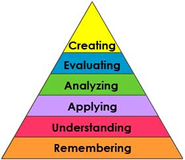


Applying Higher
Order (Bloom's Taxonomy) Thinking Skills
The concept of higher order thinking skills became
a major educational agenda item with the publication of Bloom et al's taxonomy
of educational objectives. Others have sought to improve on the application of
this frame
of reference, e.g., the NorthWest, Marzano and Anderson/Krathwohl models below, about which much has been written (Bloom et al, 1956; Chuska, 1995; Graesser et al, 2003; & Sanders, 1966). The revised version of 2000 is considered the current standard version (Anderson et al, 2000).
 |

|
Other models for higher order questioning and reasoning are explored:
- Bloom's model, six categories of thinking
skills, the original work from 1956.
- NorthWest Regional Labs model, a simpler or more
condensed synthesis of Bloom et al's work with five categories of thinking
skills, adapted by North Carolina in 1989; also provides definitions and
sample trigger question formats.
- Marzano's model an expansion
of Bloom's work with eight categories of thinking skills, adapted by North
Carolina in 1994; plus, definitions and sample student writing, with ratings
by state scorers.
- Anderson/Krathwohl model (2000). Anderson was a former student of Bloom and Krathwohl one of Bloom's original partner's and co-author of the seminal work on cognitive skills. See also key thinking worksheets and Kurwongbah State's work.
Categorizing Bloom's Model with digital literacy knowledge and application
Building such a matrix is challenged by the morphable nature of thinking tools. With a bit of thought, almost any interesting application can be used at many if not all levels of Bloom's taxonomy. Here are a couple of matrix attempts that are stimulating to consider and challenge.
|
Critical Reflections
The educational policies of Back to Basics and the ABC's do not have to
be in conflict with higher order thinking. One cannot think without facts.
But the reverse does not hold true. Putting the accent on facts and recall
does not in turn spontaneously generate higher order thought. "The most
important single message of modern research is that it is false to think
that there is a sequence from lower level activities that do not require
much independent thinking or judgment to higher level ones that do" (L.
Resnick quoted by Kohn, 1998).
The
most important single message emerging from the information age and the
economy of its Web is that higher order thought is not just central to
its future, but is its present and your future.
The CROP site models many methods for keeping higher order thought central
to its use. Once your thinking has targeted problems of interest to yourself
and to others, use the SUP: Sharing Problems link at the top of
this page to put your question topic in play. Send email to others of your
question's location in the SUP database and invite their participation
in making contributions.
Brief Bibliography
Anderson, L. W. and David R. Krathwohl, D. R., et al (2000) A Taxonomy for Learning, Teaching, and Assessing: A Revision of Bloom's Taxonomy of Educational Objectives. Allyn & Bacon.
Bloom, B., Englehart, M., Furst, E., & Krathwohl, D. (Eds.). (1956). Taxonomy of educational objectives: The classification of educational goals. Handbook I: Cognitive domain. New York: David McKay.
Brookhart, S. M. (2010). How to Assess Higher-Order Thinking Skills in Your Classroom. Association for Supervision & Curriculum Development.
Chuska, K. (1995). Improving classroom questions: A teacher's guide to increasing student motivation, participation, and higher level thinking. Bloomington, IN: Phi Delta Kappa Educational Foundation.
Graesser, A. C. ; Gernsbacher, M. A. , Goldman, S. R. (2003). Handbook of discourse processes. Mahwah,
NJ: Lawrence Erlbaum. Retrieved March 23, 2009 from Google Books.
Sanders, N. M. (1966). Classroom questions: What kinds? New York: Harper & Row. (Available in Hunter Library)
Sevilla, M. (2012). Developing Common Core Thinking Skills. Amazon Digital Services.
Additional References
Search of Google Scholar for "classroom questions"
Search of Google Scholar for "Bloom's Taxonomy"
[ 2005, 5.42 updated March 9, 2012 | page author Houghton ]





